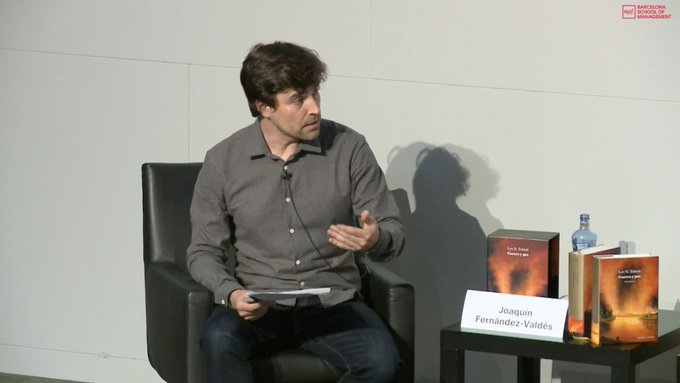The translator into Spanish of Tolstoy's War and Peace, Joaquín Fernández Valdés, tells us about the four years he has dedicated to the translation of the epic and brings us closer to the reality of the Russian author in collaboration with ACE Traductores and the Master in Literary and Audiovisual Translation from the UPF-BSM.

"«Do you want to translate War and Peace?», like this, point-blank. And I almost fell off my chair". This is how Joaquín Fernández-Valdés described the commission from Alba Editorial to translate Lev N. Tolstoy's epic during the conference organized by the Culture Program of the UPF Barcelona School of Management in collaboration with ACE Traductores and presented by the director of the Master in Literary and Audiovisual Translation, Ana Mata Buil.
Over four years, Fernández-Valdés took on a task that "scared" him, as this is the first completely revamped revision of War and Peace into Spanish in the last 40 years. "I've been four years late", acknowledged the translator, who admitted that "there were changes right up to the moment of printing". "If they had let me, I would have made a thousand more changes", he said ironically, along with Helena Aguilà Ruzola, vice-president of ACE Traductores and host of the talk.
"My coach became a small library", admitted Fernández-Valdés as he recounted how he documented both the translation and the introduction, available in the version published by Alba Editorial. Both documentation and organization were crucial for the translator, since, as he said, "if you don't have a database, you are lost". To this end, Fernández-Valdés insisted that the publisher include a map with the geographical points where the story takes places and a small family tree of the families in War and Peace, which has more than 550 characters.
During the time in which Fernández-Valdés has been immersed in the translation of Tolstoy's epic, he has encountered various obstacles, which he has been unraveling through questions from Aguilà Ruzola, but also from experts in Slavic literature who have participated in the talk virtually. From the general secretary of ACE Traductores, Marta Sánchez Nieves, who asked about the dilemmas of translation and transliteration, to the translator Olga Korobenko, who introduced one of the most interesting questions of the meeting: Do publishers needs to bring in native experts to fill the gaps that elude translators?
Fernández-Valdés has welcomed this initiative, as he admitted that he himself always uses native speakers. "I doubt many things, but even more about Russian", said the translator, who explained that he collects "doubts that come up and every 15 days or so I meet with a native expert to solve them together". However, both the translator and Aguilà Ruzola agreed in warning that the reality of publishing houses is different and that "it is not viable".
"The text of War and Peace is an antidote to depression, because it is a hymn to life", said Tamara Djermanovic, professor of Slavic literature in the Department of Humanities at the Pompeu Fabra University and one of the special guests at the session. After this comment, Djermanovic was interested in Fernández-Valdés' relationship with the text during these four years, to which the translator responded: "It is impossible not to be swallowed by War and Peace when you read it; once you translated it, it is obsessive".
Travel to learnOne of the things Fernández-Valdés, was most grateful for during the session was the having been able to visit the Tolstoy property. "The fact of knowing where he lived helped me to approach the writer in a spiritual, emotional way, which was crucial for me to translate him", said the translator. "It is not essential to walk on the same ground as the author to translate, but it is very useful", said Fernández-Valdés, who also recommended that translation professionals use the audiobook.
An inner journey is precisely the one that Tolstoy makes from his early works to the great epic of War and Peace. However, far from what it may seem, "what is at the end of his work was already there at the beginning", said Fernández-Valdés. "Tolstoy never chose a straight path between A and B, but rather traces circles that advance slowly from point A to point B", argued Fernández-Valdés, exemplifying it with a technique in which he believes the Russian author was brilliant: "that state of slumber, of passing from the world of the living to the world of the dead. No one has done it like him. With him, even deaths are beautiful".